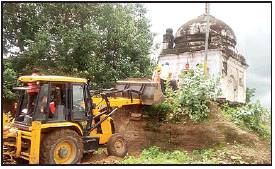Religious shrines, houses of worship: South Asia
This is a collection of articles archived for the excellence of their content. |
Contents |
Repairing shrines damaged by vandals
Can a court ask states to rebuild shrines: Indian SC asks
The Times of India, Aug 27 2015
Dhananjay Mahapatra
Can a court ask states to rebuild shrines: SC
NGO wants Guj govt to atone for 2002 riots
The Supreme Court faced a tricky constitutional question -`whether courts could direct a state to rebuild religious places damaged due to its failure to maintain law and order'.
The question was faced by a bench of Justices Dipak Misra and P C Pant as it started final hearing on a petition filed by the Gujarat government challenging a high court order that the state was duty-bound to reimburse the cost of restoration of shrines damaged during the 2002 communal riots.
Appearing for Islamic Relief Centre, Gujarat (IRCG), senior advocate Yusuf Muchala said the state had completely abdicated its constitutional role to maintain law and order and protect lives and property of citizens during the riots and hence, it was its secular duty to restore the mosques and dargahs damaged by mobs.
“The NHRC had directed the state to conduct a survey of damage to places of worship of Muslims during the riots. A defiant state which had failed to protect the religious places belonging to minority community has conducted no such survey even after more than a decade. The religious minority suffered gravely . Attack on religious places was an attack on the religious identity of the community . The motive was to inflict humiliation on the minority ,“ Muchala said.
For the state, additional solicitor general Tushar Mehta told the bench that a scheme was framed by the government to pay compensation to religious places at the rate applicable to damaged residential and commercial properties.
However, Mehta put a constitutional caveat, “Right to practice, profess and propagate any religious belief is part of fundamental rights. But right to worship from a particular place is not. Is giving compensation to rebuild religious places part of the secular scheme of governance? Under the constitutional scheme, a court cannot direct a state to utilize taxpayers' money for religious purposes. Most of the damaged religious places have been restored with community funding. Even if the state was directed to meet the expenses incurred, to whom should it be paid?“ The bench had a different concern. How could the HC designate district judges as special officers and task them with assessing damage to the shrines and quantify the cost of restoration, it asked.
“...under what procedure of law will the district judge gather evidence about damage, examine witnesses and allow their cross-examination and quantify the damages? Moreover, in civil law, there is a time limit for claiming compensation.That time limit expired a long time ago. A court cannot extend that period of limitation,“ the bench said.
Pakistani SC does just that
The Times of India, Aug 27 2015
Pakistan's top court orders rebuilding of Hindu temple
Pakistan's Supreme Court has ordered the rebuilding of a Hindu temple destroyed by fanatics in Khyber Pakhtunkhwa province.
Athree-judge bench headed by chief justice Jawwad S Khawaja passed the order. The court asked Ramesh Kumar Vankwani, a National Assembly member, Arbab Mohammad Arif, the provincial home secretary , and Shoaib Jadoon, the deputy commissioner, to come up with a plan to rebuild Shri Paramhans Maharaj's Samadhi in Teri village, Dawn online reported. The chief justice said the order must not be defied and be implemented at all costs.
The shrine and temple were built at the spot where a Hindu holy man, Shri Paramhans, was buried in 1919. His followers visited the temple frequently till 1997 but some fanatics dismantled it.
The devotees tried to rebuild the temple but the land was allegedly under the occupation of a local mufti, Iftikha ruddin. Jadoon told the SC that its earlier order on restoring the temple was carried out and aboundary wall built around it.
But the court declared that the efforts put in by the administration were not enough and proposed a new building instead of just erecting boundary walls.
Relocating shrines for developmental projects
The Jalaun example/ 2018

From: Arindam Ghosh, Hindus & Muslims unite to shift shrines, pave way for a highway, September 9, 2018: The Times of India
In an exemplary show of cooperation and amity, signaling the importance and precedence of infrastructure and development over faith and belief, locals from two communities agreed to relocate two temples, a mosque and three mazars (enshrined tomb) in Jalaun to pave way for the Lucknow-Jhansi national highway. The shrines had been impeding the work since last 14 years.
The structures were taken apart on Saturday amid heavy deployment of security forces without a single incident of protest.
The decision to relocate the shrines was taken after the district administration, led by Jalaun district magistrate Mannar Akhtar and SP Arvind Chaturvedi, held dialogue with the leaders and members of the two communities for over six months in what is being termed as ‘Operation Cooperation’.
Officials told TOI that there were two temples — one of Lord Shiva and one of Goddess Durga — three mazars and a mosque — all 50-100 years old structures — that came in the way of the highway. As a result, there was a daily traffic jam on the stretch to up to three hours.
The DM said the places for relocation of the six structures have already been identified and the National Highways Authority of India has taken the responsibility to rebuild them.
The relocation work started simultaneously at all the places. BJP city head Amit Pandey said, “Almost 130 people died in accidents because of this traffic bottleneck. It is indeed a big step towards development.”